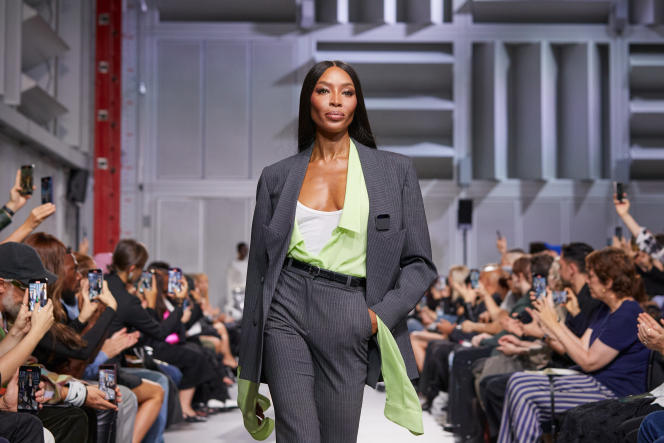If screenwriters, actors, translators or journalists fear being pushed into unemployment by tech and artificial intelligence, will fashion designers be spared? A year ago, in the middle of Paris fashion week, Sébastien Meyer and Arnaud Vaillant, the couple behind the Coperni label, staged a viral happening which seemed to suggest such a scenario. It showed a dress come to life live on model Bella Hadid, covered in a material applied in a spray that ended up freezing to create a textile.
In March 2023, robot dogs, supposed to symbolize a shared life between humans and machines but which, in truth, froze the audience, paraded alongside models dressed as sort of geeky Red Riding Hoods.
Friday September 29, for their latest collection presented in the basement, in the newly renovated “projection space” of the Institute for Acoustic/Music Research and Coordination (Ircam), a stone’s throw from the Center Pompidou, the tech touch is barely perceives. “We wanted to put the emphasis back on clothingexplains the couple. Let there be as little distraction as possible. »
Musical winks
Ircam, dedicated to sound research, and its room lined with three hundred moving speakers, becomes the ideal biotope for a collection where musical references are numerous: walkman bag, heels of pumps in the shape of trumpet mouthpiece or jack socket, rigid corset in gold brass like a tuba bell, black dresses or tops openwork with triangles, tank tops with (decorative) speakers at chest level, in collaboration with the manufacturer Transparent.
Sébastien Meyer says he wanted to design a locker room “between the student at the conservatory” (nonchalant jeans, shirts with tied sleeves, sneakers and sportswear in collaboration with Puma) and “the serious piano teacher” but sassy (nighties stitched with 3D printed embroidery).
Although small, hung like a brooch, a strange box, resembling a pager and equipped with a green light, nevertheless plays an important role in the words of the founders of Coperni. Called AI Pin, this connected pin is signed Humane, a company with 250 employees based in San Francisco and launched by the couple Bethany Bongiorno and Imran Chaudhri, a programmer and a designer who met at Apple in Cupertino. The tool, planned for marketing in the United States from mid-October, will allow “to do everything a smartphone already allows you to do”promises Imran Chaudhri.
Understand: read your messages, sort data, measure your state of health… All, via this small box which, using an LED light, projects images and texts that you can read on your own outstretched hand. “Our smartphones have already become extensions of ourselves. However, artificial intelligence makes it possible to integrate more powerful, finer, more personalized tools. By discovering the Coperni collection, we had confirmation that fashion was the best way to show that such a tool can fit naturally into our lives”pleads Bethany Bongiorno.
PVC turns blue, magenta, yellow, green
“For many, tech rhymes with industrialization and dehumanization. For me, on the contrary, it is a possibility of strengthening our ability to feel emotions”, says Kunihiko Morinaga. The Japanese designer, founder of the Anrealage label, collaborated with the materials manufacturer Shikibo.
In a dark room at the Palais de Tokyo, he brought out models in tight white jumpsuits, wrapped in a transparent changing room: coats inflated like a balloon or jackets crumpled like bubble wrap, all in PVC “phthalate-free”would like to emphasize the designer.
Often in pairs, the models, flanked by the public on a stage, walk around it before placing themselves in the center. The white light then disappears to the benefit of UV: on contact with the rays, between the large visible seams or the traditional crochet lines, the PVC becomes blue, magenta, yellow, green, like a child who has suddenly filled coloring with enthusiasm.
“Beauty from the invisible”
“Last season, we showed that clothing could change color upon contact with light. This time, with photochromy applied to a transparent textile, I wanted to bring out beauty from the invisible”, details Morinaga with his usual poetry. His technology, called Anvisual and which he has patented, will work in the same way in daylight once the pieces from the collection go on sale.
Tech and fashion, happy marriage? “ We always wanted to believe in their cohabitation”assure Arnaud Vaillant and Sébastien Meyer. “Tech can reconcile us with the world: we must not think only in terms of confrontation between it and us”says Kunihiko Morinaga.
Newsletter
“The Taste of the World”
Travel, fashion, gastronomy, design: the best of the art of living, in your email box
Register
The fact remains that by advocating for a more fluid and less thunderous integration of digital technology into our lives, designers have lost their power of impact. While their productions had gone viral during previous seasons, their performances were this time greeted with benevolent but more reserved applause… Welcome habituation to tech or cruelty of the fashion public, so quickly jaded? The incorporated technologies in any case required much more than six months of production: Humane’s AI Pin required five years of development when Anrealage took ten years before finding, with Shikibo, the right formula for its PVC which seems to be dyed. by magic.
